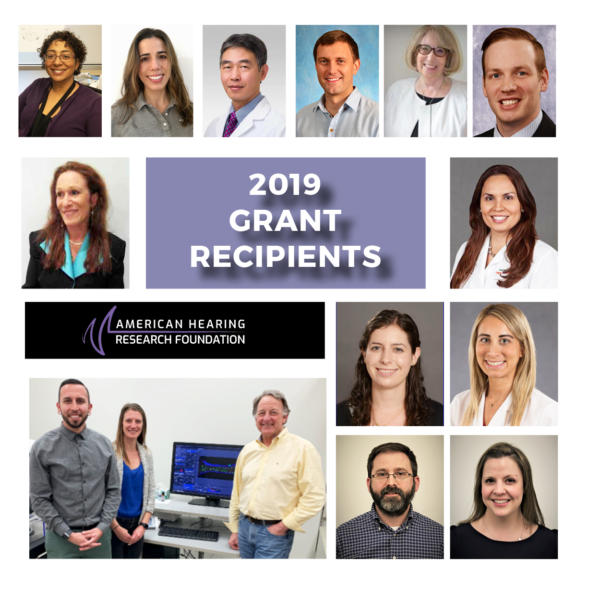 Elmhurst, Illinois – February 7, 2019 – The American Hearing Research Foundation (AHRF) announced that in January 2019, it awarded ten grants to investigators who are exploring hearing and balance disorders of the inner ear. AHRF awarded over $250,000 in grant monies in 2019.
Elmhurst, Illinois – February 7, 2019 – The American Hearing Research Foundation (AHRF) announced that in January 2019, it awarded ten grants to investigators who are exploring hearing and balance disorders of the inner ear. AHRF awarded over $250,000 in grant monies in 2019.
AHRF President Alan Micco, MD, commented, "We were excited by the novel ideas in the proposals. It was difficult to choose. We funded scientists who are pursuing new ideas, and projects whose results could have the greatest impact on how we understand and treat hearing and balance losses."
Seven grants of $20,000 to $50,000 were awarded, plus three grants of approximately $1,000 each for otolaryngology residents. Recipients will explore diverse topics, including ways to deliver hearing-protective drugs to those receiving cancer treatments, gene therapy approaches for inherited hearing loss, sound processing problems associated with autism, and how noise exposure causes changes in a specific region of the brain.
One of the AHRF grants was issued in partnership with the American Cochlear Implant (ACI) Alliance. The two organizations co-sponsored a one-time grant of $25,000 for a planning study that will evaluate the lifetime cost and burden of severe to profound hearing loss. One of the project's three principal investigators, Alexandria Quittner, PhD (Nicklaus Children's Research Institute), explains, "If deafness exists before a child acquires speech and language (typically age 3), the lifetime costs to society exceed $1 million per child, according to the Mohr (2000) study. The goal of this multi-disciplinary project is to replicate this study, and extend it by following children with cochlear implants for 13 to 15 years."
In 2019, three otolaryngology residents received a Bernard & Lottie Drazin Resident Grant. AHRF offers this grant program to encourage individuals who might pursue a career in hearing and balance research. Each year AHRF offers up to five $1,000 awards to otolaryngology residents at specific institutions. Residents in their third year of otolaryngology programs are required to conduct basic science or clinical research projects.
The 2019 grant recipients, academic institutions, and research projects are:
American Cochlear Implant Alliance/AHRF Partner Grant ($25,000)
- Alexandra L. Quittner, PhD; Ivette Cejas, PhD; Laurie Eisenberg, PhD; Nicklaus Children's Research Institute, FL; Reductions in Societal Costs and Burden for those with Severe to Profound Hearing Loss: Impact of Pediatric Cochlear Implantation
AHRF Regular Grants ($20,000 to $50,000)
- Charles Askew, PhD; Chengwen Li, MD, PhD; University of North Carolina at Chapel Hill; Development of Adeno-Associated Vectors for Genetic Treatment of Inherited Hearing Loss
- Christopher G. Clinard, PhD; Erin G. Piker, AuD, PhD; James Madison University, VA; A more sensitive measure of age-related changes in the vestibular system: Vestibular evoked myogenic potentials (VEMPs) elicited by amplitude-modulated tones
- Larry Hoffman, PhD; Ashley Kita, MD; Johnny Saldate, PhD; Geffen School of Medicine at UCLA; Designing a drug-eluting scaffold for ototherapeutics
- Tessa-Jonne F. Ropp, PhD; University of North Carolina at Chapel Hill; Exploring Deficits in the Auditory Cortex Associated with Autism
- Marina Augusto Silveira, PhD; University of Michigan; Neuropeptide Y as a Neuro-modulator of Noise-Induced Hyper-excitability in the Inferior Colliculus
- Xiaodong Tan, PhD; Northwestern University, IL; Protective Effect of Honokiol in Noise-Induced Hearing Loss
Bernard & Lottie Drazin Memorial Grants for Otolaryngology Residents ($1,000)
- Erin R. Cohen, MD; University of Miami Miller School of Medicine; Radiation Toxicity and Biology in Merlin-Deficient and Normal Schwann Cells in Vitro
- Nathan R. Lindquist, MD; Baylor College of Medicine, TX; "Evaluation of cognitive function in hearing loss patients utilizing the BrainCheck
 computerized assessment tool
computerized assessment tool - Elise Lippmann, MD; University of Illinois at Chicago; Validating the use of a non-linguistic test across a broad clinical population
About AHRF
AHRF is a nonprofit organization that has been making new discoveries possible for more than 60 years by funding novel research to better understand and overcome hearing and balance disorders of the inner ear. Since 2010, the organization has funded 76 projects with more than $1.6 million in research grants.
For more information on AHRF, visit www.American-Hearing.org. Donations for research funding can be made online.
Follow AHRF on Twitter. Like AHRF on Facebook. Sign up for newsletter updates on the AHRF homepage.
The post American Hearing Research Foundation awards 10 grants in FY19 appeared first on American Hearing Research Foundation.
from #Head and Neck by Sfakianakis via simeraentaxei on Inoreader http://bit.ly/2HWQBZn